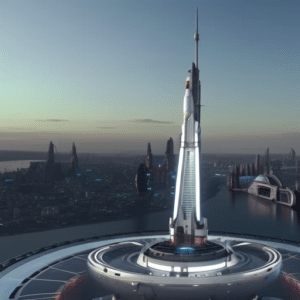El metaverso es un concepto de realidad virtual que se ha convertido en una tecnología cada vez más importante e influyente. Está abriendo nuevos mundos a la exploración humana, ofreciendo experiencias y entornos virtuales inimaginables para los usuarios. La navegación veloz en el metaverso es un desarrollo reciente que otorga a los usuarios la capacidad de viajar alrededor del metaverso con rapidez asombrosa, como si estuvieran deslizándose sobre el viento. Permitiendo a las personas acceder rápidamente a sus destinos, esta tecnología revolucionaria redefine la forma en que interactuamos con el metaverso y expandirá significativamente nuestras fronteras virtuales.
Overview of the Metaverse
Exploring the Metaverse offers a unique opportunity to traverse digital spaces at remarkable speeds. The concept of the metaverse is not new, having been popularized in science fiction since the 1960s, but its recent cross platform compatibility and social implications have made it an attractive reality for many. In the virtual world, users can access a variety of services such as streaming media, 3D gaming, telepresence services, and more. These services are often offered through different platforms that allow for fast navigation in this space. Fast navigation in the metaverse refers to navigating between multiple applications quickly with minimal effort from the user. This includes quick loading times and easy-to-use interfaces that make moving around within these digital realms much simpler than it would be without them. By taking advantage of these features, users can take full advantage of what the metaverse has to offer while also minimizing their time spent navigating it. Transitioning into subsequent topics such as what is fast navigation in the metaverse will further explore how speed can be maximized when exploring digital worlds.
What is Fast Navigation in the Metaverse?
Utilizing the most efficient methods, it is possible to traverse the Metaverse with great speed. Fast navigation in this virtual world is achieved by optimizing performance and navigating challenges. This requires a comprehensive understanding of the environment and its technical capabilities as well as knowledge of how to use specialized tools. This includes utilizing mapping systems, teleportation platforms, and other software that facilitate rapid travel while maintaining high levels of safety. By mastering these techniques, users can traverse immense distances within a short amount of time without sacrificing quality or experiencing undue stress. These benefits make fast navigation in the metaverse an attractive option for those who wish to explore this immersive digital realm. Transitioning into subsequent sections will further examine the advantages of fast navigation in the metaverse.
Benefits of Fast Navigation in the Metaverse
Fast Navigation in the Metaverse has many benefits, such as increased connectivity among users, reduced latency of data transfer, and improved user experience. By allowing for faster communication between users, Fast Navigation facilitates higher quality interactions within the Metaverse. Additionally, it reduces the amount of time needed to send and receive data within the environment which helps improve the overall user experience. Finally, with less lag time between actions taken by users, results are delivered more quickly and accurately which can lead to a more engaging virtual world.
Increased Connectivity
Facilitating greater accessibility, increased connectivity is key to achieving rapid navigation through the metaverse. High speed networks and networked devices are essential for enabling such connectivity. This allows for a more seamless transfer of data across different platforms, creating an enhanced user experience. With faster transmission rates, users can access content quickly and move between various digital locations with ease. In addition, users can share information with one another in real time without worrying about lag or buffering times which would otherwise result when using slower speeds. As a result, this improved connection enables users to take advantage of all the features that the metaverse has to offer while navigating it at high speeds. This also ensures that connections remain secure and reliable so that any sensitive data is not compromised during transmission. By leveraging the power of high speed networks and networked devices, users can enjoy greater connectivity while exploring the virtual world at lightening speeds.
Reduced Latency
Reduced latency is critical to ensuring an enjoyable experience while traversing the metaverse, as it enables users to navigate quickly and smoothly without interruption. This can be achieved through various techniques such as dynamic routing, which allows for packets of information to be routed around congested areas or unreliable links; virtual optimization, where resources are allocated in a more efficient manner; and by minimizing the number of hops between two points on the network. These strategies result in increased speeds, lower cost per bit of data transmitted, and improved user experience.
The reduction in latency has also been shown to improve user engagement with applications and services within the metaverse. By reducing wait times between different activities, users can move fluidly from one task to another without having their progress interrupted by delays caused by network congestion or slow bandwidth speeds. This improved user experience results in higher satisfaction rates among users and encourages them to use platforms and services within the metaverse more frequently.
Increased User Experience
Enhanced user experience is an integral part of the metaverse, providing users with a smoother and more enjoyable navigation through virtual environments. User experience optimization strategies attempt to provide seamless integration between the user interface and the underlying technology, allowing for quick access to information and easy navigation in a virtual space. These strategies can include features such as providing dynamic menus that are automatically updated when new content is added, or having predictive search functions that can anticipate what the user may be looking for based on previous searches. Additionally, intuitive design allows users to easily find their way around the metaverse even if they are unfamiliar with it. By optimizing user experience, fast navigation in the metaverse becomes possible without sacrificing comfort or ease of use. With this optimized approach, users can enjoy faster access to content while still feeling secure within their environment. This increased level of confidence leads to better engagement within virtual spaces and an overall improved user experience. From this enhanced user experience then follows a more efficient exploration of the metaverse which will be discussed in the following section about ‘the technology behind fast navigation in the metaverse’.
The Technology Behind Fast Navigation in the Metaverse
The technology behind fast navigation in the metaverse is rooted in a combination of hyperlinks, augmented reality, virtual reality, and artificial intelligence. Hyperlinks are fundamental for allowing users to rapidly jump between different locations within the metaverse. Augmented reality and virtual reality allow users to experience immersive environments with 3D visuals and audio while navigating through the metaverse. Finally, artificial intelligence adds an extra layer of interactivity by enabling automated responses that can provide useful information or services to users as they move through the metaverse.
Hyperlinks
Navigating the metaverse through hyperlinks allows for a more efficient exploration of its vastness. Hyperlinks, when used in conjunction with 3D mapping and content curation, can help users quickly find the information they need within the vast virtual environment. They also allow for quick transitions between different areas of the metaverse, ensuring that users are able to move from place to place without having to search extensively for what they are looking for. This allows them to spend less time searching and more time exploring and interacting with the various environments within the metaverse. By making navigation easier and faster, hyperlinks offer an invaluable tool for those looking to explore this new realm. With their help, users can traverse large distances in a short amount of time while enjoying an immersive experience. As such, hyperlinks are essential components of fast navigation in the metaverse. From here, augmented reality takes over as another powerful tool that helps make navigating this virtual world even easier.
Augmented Reality
Augmented reality offers further enhancements to the navigation experience within the metaverse, allowing users to explore their environment in a more immersive and interactive way. By utilizing wearable technology such as glasses or headsets, virtual elements are overlaid onto a user’s view of the real world. This can be used to provide greater context when navigating difficult terrain or unfamiliar spaces, while also enabling users to interact with digital objects they encounter within the metaverse. Additionally, augmented reality enhances communication between users by giving them access to information and features that would normally be out of reach in physical environments.
In terms of navigation, augmented reality enables people to navigate large areas quickly and easily by using directions projected onto their view of the environment. Furthermore, it allows for real-time 3D mapping which helps create detailed representations of any space being explored without needing physical markers or signs. As such, augmented reality can open up entirely new ways for people to experience the metaverse and make use of its many capabilities. With this technology at hand, users will have unprecedented access to enhanced navigation experiences that bring together both virtual and real-world elements seamlessly. Moving forward into the future of virtual exploration, augmented reality is sure to play a major role in how we traverse our ever-expanding metaverses.
Virtual Reality
Virtual Reality (VR) provides users with an immersive, three-dimensional experience of the metaverse, allowing them to explore and interact with digital objects in a way that is not possible in the physical world. By leveraging augmented analytics and AI driven navigation, VR enables users to traverse through the metaverse quickly and efficiently. This allows for faster access to content and information than ever before, enabling users to make more informed decisions quickly. Additionally, by providing virtual environments that are more realistic than traditional video game graphics, VR can be used to create lifelike simulations that have applications in many industries including medical training and military exercises. By utilizing advanced analytics and artificial intelligence combined with virtual reality technology it is possible for users to navigate through the metaverse at unprecedented speeds. As such, VR has become an important tool for optimizing navigation throughout the metaverse which can result in improved user experiences. With this increased speed of navigation enabled by VR comes great potential for further exploration within the metaverse as well as more efficient use of time spent there. Moving forward artificial intelligence will continue to play an increasingly significant role in facilitating faster navigation within virtual environments.
Artificial Intelligence
Artificial Intelligence (AI) has become a powerful tool for optimizing navigation within the metaverse, allowing users to traverse through digital environments quickly and efficiently while providing more lifelike simulations than traditional video game graphics. By leveraging AI driven navigation techniques such as Machine Learning and Neural Networks, users can interact with virtual worlds as if they were in the physical world. AI-powered navigation tools provide more precise and accurate controls over movement, enabling smoother transitions between areas of the metaverse while also allowing for quicker routes to be taken. Furthermore, AI can enable rich sensory experiences for users as they explore new places in virtual reality. As a result of this, fast navigation in the metaverse is becoming more accessible and efficient due to advances in Artificial Intelligence. This opens up a range of possibilities for creating immersive virtual experiences that are tailored to individual user preferences. With this potential in mind, it is interesting to consider how artificial intelligence will continue to shape our interactions with digital environments in the future.
Applications of Fast Navigation in the Metaverse
Speed of navigation within the Metaverse has enabled potential applications in various industries. These include virtual collaboration, increasing efficiency, and enabling remote work. With such capabilities, a wide variety of new services become available for users to interact with each other and their environment. However, this technology also raises ethical considerations as there is an increased potential for misuse or abuse of the system. For example, it could potentially lead to privacy breaches if not implemented correctly. As such, there are numerous challenges associated with fast navigation in the metaverse that must be taken into account before any implementation. This includes developing protocols that ensure user safety and security as well as addressing questions related to data management and storage. By taking these precautions and ensuring appropriate policies are in place, fast navigation can open up many new opportunities while still maintaining a safe digital environment for users.
Challenges of Fast Navigation in the Metaverse
The implementation of fast navigation in the Metaverse presents a number of challenges that need to be considered for successful adoption. One such challenge is the development of artificial intelligence (AI) algorithms that can accurately map and track user movements within the Metaverse environment. This is especially challenging due to the fact that it requires real-time processing capabilities and advanced AI algorithms in order to navigate, detect, and respond quickly to changes in the user’s environment. Additionally, the development of metaverse mapping techniques poses an additional challenge as these must also be accurate while being able to provide near instantaneous responses to user inputs. As a result, developing AI systems that are capable of navigating complex 3D environments with speed and accuracy is critical for ensuring reliable fast navigation in the Metaverse.
Moreover, security considerations are another important factor when considering fast navigation in the Metaverse as this requires users’ data to be securely stored and managed while enabling users to easily access their personal data from any device connected with their account. Therefore, ensuring secure data management will be essential for providing users with safe access across all devices connected with their account while maintaining privacy through encryption protocols.
Security Considerations
Security is an important consideration for fast navigation in the Metaverse, as it requires user data to be managed securely while allowing users to easily access their information from any device. To ensure secure access and data integrity, the Metaverse must have a reliable system of authentication, authorization and encryption protocols that can protect user data from unauthorized access or manipulation. Additionally, appropriate measures should be taken to monitor user activity and prevent malicious actors from exploiting vulnerabilities in the system. By following these standards of security, users can feel confident that their data will remain private and secure while enabling them to navigate quickly through the Metaverse. This allows for a more seamless experience when navigating the virtual world with minimal risk of compromising personal information or being exposed to malicious content. The next section will discuss the impact on society this type of fast navigation has had.
Impact on Society
The fast navigation of the Metaverse has had several impacts on society, both positive and negative. One of the most profound impacts is an increase in remote work opportunities, which have been amplified by social media networks like Twitter and Instagram. As a result, many people now have the potential to find employment across the world with just a few clicks. Additionally, fast navigation in the metaverse has enabled businesses to connect with customers more quickly and cost-effectively than ever before. This has opened up new revenue streams for companies that would not otherwise exist without such technology. On the flip side, there are also some concerns about privacy issues when navigating through virtual spaces at high speeds. Furthermore, certain activities may be restricted or even illegal depending on where one is located while using this technology. Ultimately, it is important to consider all aspects of fast navigation in order to understand its full impact on our society moving forward. With this knowledge in hand, we can move ahead towards a brighter future for all involved.
Future of Fast Navigation in the Metaverse
Fast navigation in the Metaverse is poised to have a lasting impact on society in the future. Enhanced visibility and seamless integration of virtual realities will provide opportunities for people to engage with one another, access educational resources, and more. The following points are indicative of its potential:
- Increased efficiency in communication between distant individuals and groups.
- Broader reach of entertainment experiences, such as gaming or theater viewing parties for dispersed audiences.
- Improved access to important services that were previously limited due to geographical restrictions, such as healthcare and education resources.
- More immersive collaboration platforms that enable remote workers to share ideas and work together more effectively from different locations around the world.
The rapid development of fast navigation technology has immense implications beyond mere convenience – it serves to open up new realms of possibilities for individuals all around the globe who may otherwise be unable to interact with each other due to physical constraints or economic barriers. With this newfound freedom comes the responsibility of establishing appropriate regulations so that these advancements are used ethically and safely; thus providing a promising framework for transitioning into subsequent discussions about regulatory issues surrounding fast navigation in the metaverse.
Regulatory Issues
The rapid growth of the Metaverse has presented challenges in terms of regulation, particularly with regards to privacy and data protection as well as intellectual property protection. Virtual environments are often complex systems that contain a vast amount of user data, making it difficult for existing regulations to keep up. Additionally, current laws may not adequately protect virtual assets due to their intangible nature. Thus, there is an urgent need for governments to create new laws and regulations that address these issues in order to ensure the safety and security of users in the Metaverse.
Privacy and Data Protection
Navigating the metaverse at high speeds can bring about heightened concerns for privacy and data protection. Data breaches, online privacy, identity theft, and cyber attacks are all risks associated with navigating the metaverse, especially when doing so quickly. The transfer of sensitive information in a digital environment is particularly vulnerable to attack due to its speed and convenience. To protect user information from unauthorized access or disclosure, organizations must implement comprehensive security measures such as encryption technology and authentication processes. Furthermore, users must be aware of their own personal responsibility in protecting their data by adhering to best practices such as regularly changing passwords.
Transitioning into the next subtopic of intellectual property protection requires a careful consideration of how digital content is being used and shared within the virtual world.
Intellectual Property Protection
Navigating the metaverse can present challenges in terms of protecting intellectual property rights. This is due to the fact that digital media and content are easily replicated, shared, and distributed online without authorization, leading to IP licensing issues and software piracy. Copyright protection measures have been implemented in an attempt to protect creators from having their work pirated or stolen. However, these protections can be difficult to enforce in a virtual environment where individuals have access to sophisticated tools that allow them to manipulate digital content with relative ease. The best way for digital content creators to ensure that their work is adequately protected is through the use of robust IP licensing agreements that clearly define how their work may be used by others. These agreements should also include measures for monitoring potential infringement and provide mechanisms for enforcement against illegal acts of copyright infringement.
Best Practices for Fast Navigation in the Metaverse
Exploring the Metaverse efficiently requires an understanding of best practices for fast navigation. To maximize user experience and efficiency, smart navigation techniques should be implemented to facilitate a seamless transition between related environments. Navigation strategies such as preserving context information, reducing cognitive load, and utilizing automated tools can enhance the speed of navigation in the virtual world. For example, using pre-made models or prefetching data can reduce the time it takes to traverse vast areas of the Metaverse. Additionally, search engine optimization techniques like keyword tagging and content categorization can help users quickly find what they are looking for without wasting time on irrelevant content. These tactics will help accelerate the process of navigating through different parts of the Metaverse while improving overall user experience. As such, these strategies should be taken into account when aiming to navigate quickly within this virtual space.
Examples of Fast Navigation in the Metaverse
Utilizing fast navigation strategies in the Metaverse can greatly enhance user experience. Cross platform compatibility and user engagement are both essential elements to consider when developing a fast navigation system in the Metaverse. These two factors allow users to quickly move between different platforms without any lags or technical issues. For example, some popular games such as Fortnite and Minecraft have implemented cross-platform compatibility that allows users to seamlessly transition between computer, console and mobile versions of the game. Additionally, developers should take into account user engagement in order to create a smooth navigation process that will keep players engaged for longer periods of time. By incorporating features such as leaderboards and customizable avatars, players can be encouraged to explore new areas of the Metaverse while navigating quickly within them. With these considerations taken into account, developers are able to create a fast navigation experience that is both enjoyable and efficient for users. As a result, this can lead to increased user satisfaction with their overall experience in the Metaverse. Transitioning from this topic, there are also certain common pitfalls that need to be avoided when creating an effective fast navigation system in the Metaverse.
Common Pitfalls to Avoid
When creating a fast navigation system in the Metaverse, there are certain common pitfalls that should be avoided to ensure a smooth experience for users; these include things like complex user interfaces and confusing menus. To illustrate this point, imagine trying to maneuver through a virtual world with cluttered pathways and no clear direction – it can quickly become overwhelming and frustrating. It is important to keep performance optimization and latency management in mind when designing the navigational system. This will help to minimize lag times by ensuring that all assets are being loaded efficiently from the server. Additionally, UX design principles should be applied such as providing users with clear visuals cues on their journey through the metaverse. By avoiding these common pitfalls, users will have an enjoyable experience navigating through your virtual world at lightning speed!
Frequently Asked Questions
What are the costs associated with fast navigation in the metaverse?
The costs associated with fast navigation in the metaverse are largely dependent on the complexity of scaling speed and real time tracking. Such complex processes require significant computing power, software, and resources which will increase operational costs. Additionally, there may be additional fees for services such as virtual reality simulations.
How do I get started with fast navigation in the metaverse?
To get started with fast navigation in the metaverse, one must first become familiar with virtual reality and 3D worlds. This involves having an understanding of how to navigate these environments, as well as the technology necessary for successful navigation. Knowing how to access different areas quickly and efficiently is a key component of fast navigation in the metaverse.
What are some alternatives to fast navigation in the metaverse?
"Time is of the essence: when it comes to navigating the metaverse, there are alternatives to fast navigation. Virtual Reality and Augmented Reality can both be used as immersive experiences with greater control over navigation speed and direction. Specific tools such as haptic feedback devices or motion tracking capabilities can also be employed to enhance user experience."
Are there any risks associated with fast navigation in the metaverse?
Navigating the metaverse quickly can have potential risks, such as virtual fatigue or decreased learning benefits. Fast navigation can result in a lack of focus and attention on details, leading to reduced comprehension and retention of the content.
What ethical considerations should be taken into account when using fast navigation in the metaverse?
When using fast navigation in the metaverse, ethical considerations should be taken into account such as privacy implications and data safety. It is important to ensure that users’ personal data is secure and protected from potential breaches or malicious use. Additionally, users must be made aware of any potential risks associated with their online activity.






